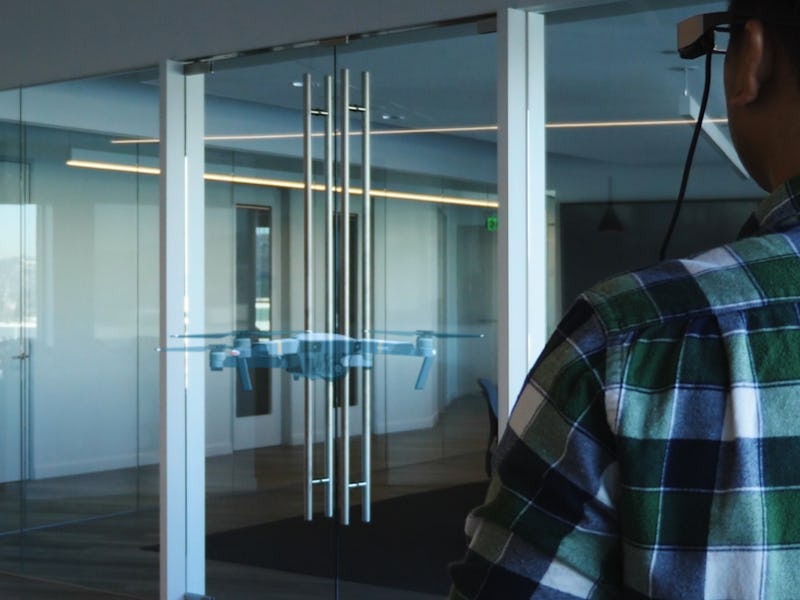How I Flew a Drone Indoors and Over New York, with Augmented Reality
No FAA regulations for phantom drones, after all.

It’s illegal to operate a drone in Manhattan, according to the Federal Aviation Administration. And while the FAA doesn’t regulate flying drones indoors, it’s generally unwise to take flight inside, say, your office.
Yet I got to do both those things when Eric Mizufuka, the product manager for new ventures at Epson — yes, the printer company — came by the Inverse office. He did bring a drone, but its rotors were left safely unattached, as it was there to help demonstrate how the company’s Moverio Smart Glasses use augmented reality to expand the drone-flying experience.
As announced Monday, Epson and its partner, the drone manufacturer DJI, have released the first drone simulator app designed for smart glasses. It’s the next logical step for the Moverio glasses, which could previously provide real-time telemetry data for users as they flew their drones.
“I would argue that this is a first really practical AR app for glasses,” Mizufuka tells Inverse. “It’s becoming very clear that augmented reality is going to be a big thing, but mostly this is for a phone- or tablet-based platform, where you’re using the phone as your lens into the world. Whereas this application is going to be a very practical application for drone pilots and for glasses.”
As Mizufuka points out, the FAA requires drone operators to keep them in sight at all times, which technically means even just looking down at the controller to check flight data is a violation and a safety hazard. The smart glasses sidestep that problem by providing the data direct to the user’s eyeballs.
The new augmented reality app takes that principle a step further, putting not just the telemetry but the drone itself — well, a simulation of it, anyway — directly in front of the user. For a total drone novice like me, flying a drone that couldn’t actually crash into the wall was a definite plus.
“It’s great that you’ve never flown a drone because now you get to get familiar with how to operate it,” Mizufuka tells me. “This mirrors the physics of a real drone as well. You get the proper tilt and speed and drop of that drone. We think this is the ultimate training tool for learning to fly.”
After a brief tutorial, I put on the glasses and took the drone hologram for a spin. It responded just like a real drone would to the various controls, moving side to side, up and down, and forward and backward at my frequently clumsy command. But then, this was my first time flying a drone, real or virtual, and my fumbling about with the controls left me thankful it was the latter.
The pensive look of someone convinced he's somehow going to find a way to real-life crash the virtual drone.
That goes double for when I stepped onto Inverse’s balcony and flew the drone out the window — through the window, more accurately — and over Houston Street in downtown Manhattan. As I sent the hologram drone zooming toward the towering dorms of New York University across the street, Mizufuka reminded me it would be illegal to do this with a real drone. No need to go search for a big empty field to go flying when I’m the only one who can see the drone fly.
Smart glasses have struggled to find their niche, even in our tech-savvy culture — just ask the makers and wearers of Google Glass. But while reasonable people can disagree over how much sense it makes to, say, wear smart glasses out to drinks with friends, Epson and DJI have found the ideal application for Moverio when it comes to drones.
The glasses aren’t cheap — they retail at $699 — so it’s hard to argue they are the ideal substitute for those who can’t afford a drone. But they provide an opportunity for people of all experience levels a chance to hone their flying skills, testing the limits of their abilities without having to worry about anything more serious than losing sight of the virtual drone and being unable to find it again. And in that case, a couple taps of the controller resets its position, so no harm done.
“We feel like this the very first glasses-based augmented reality experiences,” says Mizufuka. “It’s going to make piloting a drone safer, more productive, more fun.”
If you liked this article, check out this video of an underwater drone that lets you explore ocean life without getting eaten by a shark.